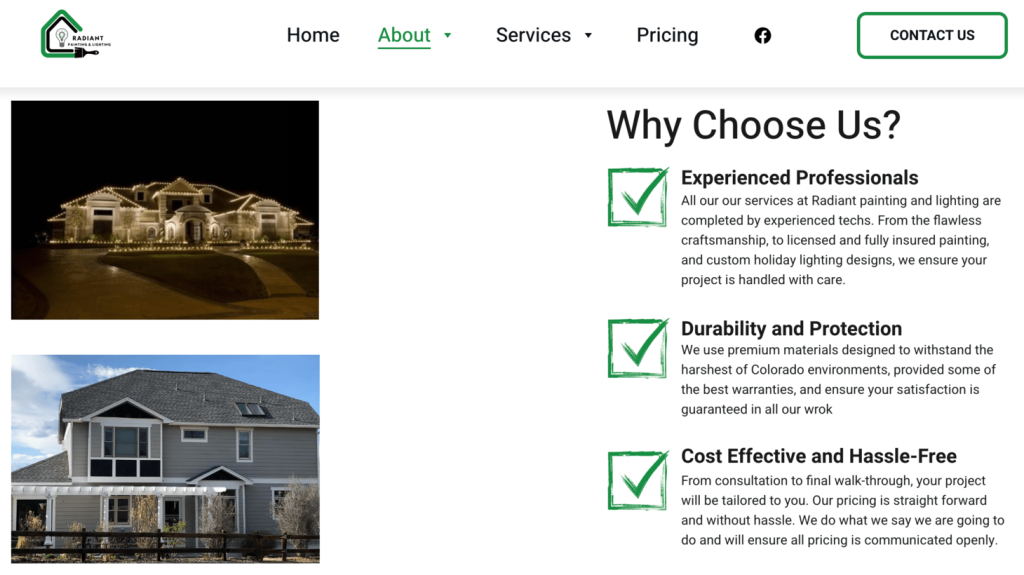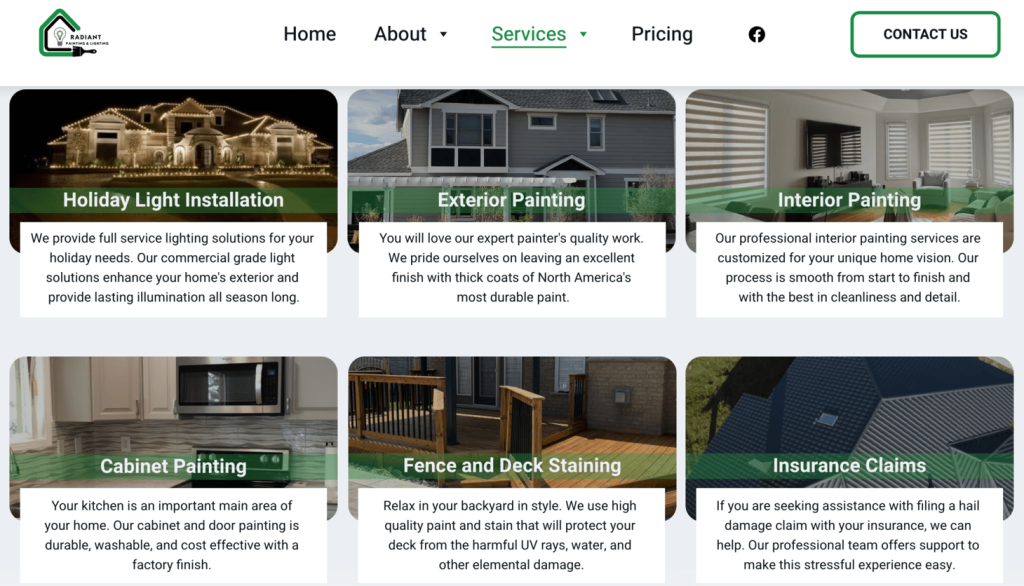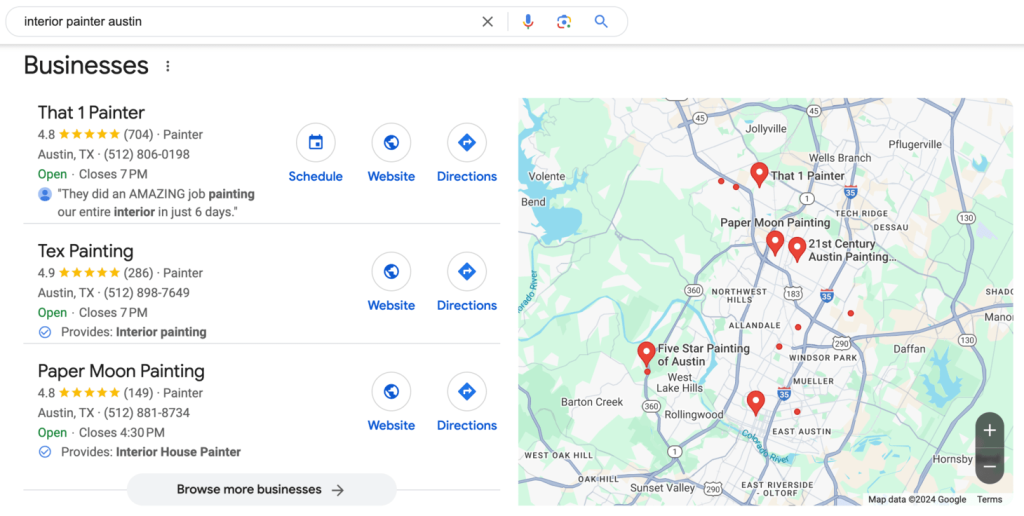How to start a painting business: A step-by-step guide

Starting a painting business is a great way to earn money doing something you enjoy.
This guide will walk you through each step to turn your painting skills into a real business. We’ll cover everything from how to plan your business to what equipment you need, how to set your prices, and how to find clients.
1. Research the painting market
When you start a painting business, it’s vital to research the market you’re entering.
Why research the market
By understanding the painting market, you can identify potential clients that might want to hire you. For example, if developers are building new homes in your area, you could offer painting services for residential buildings.
You can also gain insights into how much other painters charge. This will help you price your services fairly – not too high to drive customers away, but not too low to hurt your profitability.
On top of that, you’ll be able to develop more effective marketing strategies. For instance, if you find that local ads are the best way to reach your client base, you can allocate more of your budget to it.
How to research the market
To understand the market, gather information about your potential clients and competitors.
If you live in the area, talk to potential clients about what kind of painting services they need, how much they’re willing to pay, what they don’t like about current services, and what’s important to them when choosing a painter.
Research other painting businesses online to find out what services they offer, how much they charge, and what customers say about them.
The more insights you get, the easier it is to plan your business and set it up for success.
Radiant Painting & Lighting does a great job of understanding its market. On its website, built using Hostinger Website Builder, the company highlights its use of durable materials that can “withstand the harshest of Colorado environments”. They also offer up to 10 years of warranty.
This shows that Radiant Painting & Lighting understands its target market’s concerns about how severe weather can affect exterior paint.

2. Write a business plan
A business plan is a guide that outlines what your business does, how you will make money, and what you will do to grow. It takes what you’ve learned about your market and competition, and summarizes it into specific goals, budgets, and strategies.
Here are the key aspects of a business plan:
- Executive summary. Write a short overview of your entire painting business plan.
- Company description. Describe what services you will offer, your target clients, what makes your business unique, and your organizational structure.
- Market analysis. Explain your local painting industry, significant trends in the market, and what’s important to your potential clients.
- Marketing strategy. List the ways you will promote your business, like through social media, local newspaper ads, or by partnering with local businesses.
- Financial projections. Calculate your costs and expenses, as well as how much revenue and profit you aim to achieve.
3. Establish your brand identity
A well-crafted brand identity helps potential clients recognize and remember your painting business. It should communicate your company’s values, personality, and what makes it unique.
Creating a memorable business name
Your business name is often the first point of contact for potential clients. Choose a name that reflects your services and values. It should be easy to spell and pronounce; however, avoid generic terms and names that are similar to your competitors’.
Designing a compelling logo
A well-designed logo can help your business stand out. It should be simple and easy to recognize. Choose colors that reflect your brand personality, and make sure it is versatile enough to use in various sizes and formats.
You can design your own logo or hire a freelancer to do it for you. Or, if you build a website using Hostinger Website Builder, the Logo Maker lets you create a unique logo in an instant.

Maintain brand consistency
Ensure your brand designs, colors, and messaging match across all marketing channels. This consistency helps customers instantly recognize your business, whether they’re looking at your business cards, website, or social profiles.
For example, if you specialize in eco-friendly house painting, the messaging on your website, social media profiles, and print materials should emphasize your commitment to sustainability. You can do this by using earth-toned colors on your business cards, posting eco-friendly tips on social media, and mentioning the benefits of going green on your website.
4. Choose your painting services
One of the key decisions you make when starting a painting business is what services to offer. Will you focus on painting homes, businesses, or both? Do you want to work indoors or outdoors?
Let’s explore the different types of painting services and how to choose the right one for your business.
Interior painting
Interior painting involves painting the inside of buildings, including houses, apartments, office spaces, stores, schools, and hospitals. You might paint walls, ceilings, decorative trims, doors, and cabinets as an interior painter.
Exterior painting
Exterior painting focuses on the outside of buildings and structures, including painting the outer walls of houses as well as decks, balconies, and fences.
When exterior painting, you will often need to clean the surface with a power washer, smooth it by sanding, and apply a base coat to help the paint stick better. Depending on the location, you might also need special paint that can withstand extreme hot or cold weather.
Commercial painting
Commercial painting involves painting buildings where businesses operate, including offices, retail spaces, and restaurants. Some commercial painters also paint warehouses and factories.
You will often need to work at night or on weekends to avoid disturbing business activities.
Specialized painting
If you have specialized skills, you might want to focus on providing more specific services, such as faux finishes, murals, textured paintings, or even restoring historic buildings.
Since you might be one of the few in your area who can offer these services, specializing helps you stand out from the competition.
A great example of this is Prestige Paintwork Solutions. The company’s website, created using Hostinger Website Builder, clearly states that it is a plant refurbishment specialist.

Expanding services over time
With new painting businesses, it’s best to start small. Focus on one or two key services you’re good at and build a strong reputation in these areas first. Over time, you can ask your clients about their other needs and gradually offer more services to meet them.
Radiant Painting & Lighting is an excellent example of a company that offers complementary services. Aside from exterior painting, it offers holiday light installation, deck staining, and cabinet painting.

Offering multiple services increases your chances of having repeat business, as you become the go-to painter for all your clients’ painting needs.
5. Register your business and get licensed
The next step in starting your painting business is choosing how to structure it. This is important because it demonstrates your professionalism and protects your personal assets in case something goes wrong on the job.
The two most common options are a sole proprietorship and a Limited Liability Company (LLC).
Sole proprietorship
A sole proprietorship is the simplest and cheapest to set up. You have complete control over the business and report your income on your personal tax returns. However, you are personally responsible for any business debts.
To register as a sole proprietor, you need to file a “Doing Business As” form if you use a name other than your legal name. You then need to register for any state and local taxes that apply.
LLC
LLC costs more to set up and is a separate legal entity. This means your personal assets are kept separate from business debts and liabilities. Depending on your location, you may need to file Articles of Organization with your state’s Secretary of State office and apply online for an Employer Identification Number (EIN).
In addition to state and local taxes, you must register for employer taxes if you plan to hire employees.
Applying for licenses
You must also ensure you get the proper licenses before you start working.
Check what your state requires for a painter’s license. This might include demonstrating proof of experience, passing a trade exam, showing financial statements, and providing a surety bond, which guarantees that contractual obligations will be met.
Some states require approval to operate from home and a general contractor’s license. Certain types of work, such as removing lead paint from old houses, might also require special licenses.
Staying compliant
Make sure to renew your licenses before they expire and stay up-to-date with changes in local regulations. This might sometimes require getting new certifications to keep your license current.
6. Get insurance
To protect against risks and potential liabilities, you need to purchase insurance for your business. Proper insurance gives you peace of mind, knowing it can help to cover costs from accidents or damage.
Some states or clients may require specific types of insurance before you can start working. So, having the right insurance shows you are professional and reliable.
Here’s an overview of the main types of insurance to consider.
General liability insurance
General liability insurance is essential for any painting business. It covers injury to clients or anyone else on your work site, as well as damage to any property you may cause while working.
For example, general liability insurance protects you if a client trips over your equipment and injures themselves or if you accidentally damage a client’s furniture while painting.
Professional liability insurance
This type of insurance is essential if you provide design advice or specialized painting services.
It protects you if a client claims your services led to some kind of damage.
For example, if a client claims your color advice led to a significant loss in their property value, then professional liability insurance would cover you.
Worker’s compensation insurance
This insurance is often legally required if you hire employees or regularly use subcontractors. It covers medical costs if an employee or subcontractor gets injured on the job and includes lost wages if they cannot work due to job-related injuries.
7. Invest in quality equipment
You need the right equipment to provide high-quality painting services. Let’s review the essential tools and equipment you need to do a great job.
- Paint sprayers. These are best for large surfaces, especially outside. Look out for adjustable pressure settings and multiple spray tips.
- Brushes. Buy sizes from 1 to 4 inches for detailed work and different paint types.
- Rollers. Great for smooth surfaces, especially walls and ceilings. For comfort, it’s better to get ones with ergonomic handles.
- Ladders. For reaching high areas, get a sturdy stepladder or an extension ladder. Pay attention to the weight capacity and useful features like a wide base or non-slip feet.
- Drop cloths. Ideal for protecting floors and furniture, choose durable and reusable options to save money.
- Protective gear. Essentials include respirators, safety goggles, gloves, and coveralls.
- Buckets, trays, tape, and scrapers. These are important for mixing paint and protecting and cleaning surfaces.
Balancing cost and quality
Items like sprayers, brushes, rollers, and ladders directly impact the quality of your work, so it’s worth investing in high-quality materials. A paint sprayer can be purchased second-hand to save money, but inspect it thoroughly before buying.
You can choose budget options for equipment that does not affect the final result, such as drop cloths, buckets, trays, tapes, and scrapers.
Maintenance best practices
Proper tool care is essential to ensuring that your equipment allows you to do your job well. Here are a few tips to keep in mind:
- Cleaning routine. Clean all tools thoroughly after each use.
- Proper storage. Dedicate a clean, dry space to store your equipment.
- Regular inspections. Check equipment weekly for wear and tear.
- Replacements. Replace worn-out items to maintain high-quality results.
8. Set your pricing
It can be challenging knowing what to charge for your services. On the one hand, you want to be fair to the client, and on the other, you need to cover your costs and make a profit.
Let’s explore different pricing strategies to consider.
Per hour pricing
Charging by the hour is a simple way to ensure you’re paid for your time. This method works well for projects with unpredictable deadlines and accounts for any unexpected delays.
The downside is that it is difficult for clients to estimate the final cost in advance. For example, if you charge $50 per hour and you estimate a job takes 8 hours, the client would pay you $400. But if it unexpectedly takes you an additional 3 hours, the cost increases to $550.
Per square foot pricing
This method involves measuring the area to be painted and charging a set rate per square foot. It’s an easy strategy for clients to grasp and works well for small and large jobs. However, it doesn’t consider how complex the job is or how much preparation work is needed.
For example, you want to charge $3 per square foot. A 500-square-foot exterior wall would cost $1,500 regardless of whether it’s a single-story house with easy access or a two-story home requiring the use of ladders and extra safety measures.
Project-based pricing
With this approach, you provide a flat fee for the entire project based on your estimate of its completion time, the materials you use, and the job’s complexity.
This lets customers know exactly how much they’ll pay before you start working. However, painters risk earning less than expected if they don’t accurately predict the time and supplies required.
For example, you quote a client $800 to paint the interior of a house. Whether it takes two or four days or requires more paint than expected, the price remains $800.
A good approach is to give clients a range and then speak with them to discuss their specific needs and budget. Radiant Painting & Lighting does this well. It offers a range of exterior painting services for different-sized houses and asks clients to provide more details for a more accurate price estimate.

Tips on adjusting prices
Through your market research, you should know what local competitors charge for similar services. Make sure your pricing is always within these ranges.
At the same time, consider the value you provide that competitors might not offer. Do you use eco-friendly equipment? Are you available at unconventional hours or on weekends? Do you provide specialized services? These can all be reasons to charge more than competitors.
By considering your unique value, you can set competitive rates that ensure you cover your expenses and make a profit.
9. Create a business website and portfolio
Your painting business website lets you showcase your skills, highlight your services, and provide an easy way for clients to reach you. Fortunately, building one doesn’t have to be complicated.
One of the simplest ways to create a business website is using Hostinger Website Builder. You can have a painting business website like the ones we mentioned up and running within minutes.

Here are a few key elements to include on your painting business website.
- Details about you. To get visitors to trust you, share information about your company with a brief bio and photos. Mention any relevant certifications or awards.
- Services. Explain what services you offer and what areas you cover, and highlight what makes you unique from the competition.
- Past work. Briefly describe a few projects you’ve completed. Include before-and-after photos to showcase the quality of your work.
- Client testimonials. Feature quotes from satisfied clients, including their names and the type of work you completed. Add video testimonials for more impact.
- Contact us page. Make it easy for website visitors to contact you. Include a contact form, phone number, email, and social media profiles.
10. Develop a marketing strategy
Most people who need a painter will search online first, so you need an online presence for people to find you. Here are a few practical ways for you to attract potential clients.
Google My Business
Many people go on Google to search for a local painter. When you search for something like “interior painter austin”, this is what you see:

Those are called Google My Business listings, and that’s where you want your business to appear when someone searches for a painter in your area.
To get listed there, set up a Google My Business profile, provide your business details, upload photos, and encourage satisfied customers to leave reviews.
Social media
Another great way to get attention on your business is through social media. Here are a few strategies to use on different platforms:
- Instagram. Post high-quality photos and videos of your work, and use relevant hashtags like #housepaintingyourcity or #yourcityhomeimprovement. Interact with your followers and local influencers by commenting on their posts and responding to messages.
- Facebook. Create a Page for your business where you share photos, videos, and updates. Join local community groups and actively participate by providing helpful tips about topics related to painting.
- LinkedIn. Connect with related businesses in your area, like real estate agents and contractors. Engage in discussions to demonstrate your expertise and build relationships that could lead to referrals. You can also reach out to business owners or facility managers who could become commercial clients.
Online platforms
There are websites that help people find local plumbers, electricians, and painters. A few of the most popular ones are Houzz, Angi, HomeAdvisor, and Thumbtack.

They all work in a similar way: create a profile, and you can receive leads from homeowners looking for painting services. It’s a great way to receive job requests from local clients without much effort.
On the downside, you might have to pay for every lead you receive, regardless of whether or not they convert to a paid job. Though not all leads might convert, it could be a worthwhile way to get your first few clients.
Referrals
Referrals can be a powerful way to get the word out about your business. The easiest way to encourage people to start referring you is by offering rewards.
These rewards can be gift cards to local businesses or a discount on one of your services.
For example, you can offer a 10% discount on their next quote or a free touch-up for the first year.
You can also send personalized thank-you notes to show your appreciation. This personal touch can encourage people to continue referring new clients your way.
11. Provide exceptional customer service
Delivering outstanding customer service is vital to your long-term success. Here are different ways to provide excellent customer service:
- Communicate clearly. Explain the painting process thoroughly and ask questions about the client’s preferences to understand exactly what they want.
- Be on time. Responding to messages quickly and arriving on time shows respect for the client’s time. Plan your schedule carefully and leave early to avoid traffic. If you’re running late, call ahead and let them know.
- Respect their property. Use drop cloths to protect floors and furniture, and clean up after yourself. To avoid damage, be careful when moving your client’s stuff around.
- Be professional. Do the best job possible, and if the client is unhappy about something, listen to their concerns and offer a fair solution.
- Follow up. Call or email your client a few days after finishing your work to check whether they’re happy with it. This shows you care about their satisfaction even after you’ve gotten paid.
Providing exceptional customer service leads to clients saying positive things about you. Encourage these happy clients to leave reviews on your Google My Business Profile to gain more exposure.
You can then share these reviews prominently on your website to build trust and credibility, just like Landos Painting does on their website.

Conclusion
A painting business is a creative venture that lets you be your own boss and earn a living doing something you love.
Let’s recap the key steps:
- Research the local painting market to identify your potential clients
- Write a business plan to set clear goals for your business and ways to achieve them
- Establish your brand identity so clients know and remember who you are
- Choose the type of painting services you will provide
- Register your business and get the required licenses
- Get the proper insurance to protect against risks and potential liabilities
- Invest in quality equipment to ensure you can provide high-quality services
- Set fair prices that cover your costs and help you make a profit
- Create a website that showcases your services and lets people easily contact you
- Develop a marketing strategy that brings in clients
- Provide exceptional customer service to gain repeat clients and positive reviews
It might seem daunting to start a business, but take it one step at a time. With good planning and dedication, you can transform your painting skills into a thriving business.
How to start a painting business FAQ
How much does it cost to start a painting business?
Starting a painting business can cost between $500 and $20,000 or more, depending on your existing resources. For example, if you already own a work vehicle and only need to cover basic startup costs, the costs can definitely be lower.
Should I start a painting business?
Consider your painting skills, local market demand, competition, business acumen, and personal goals. Carefully weighing these factors can help you decide whether starting a painting business is right for you.
How profitable is a painting business?
The profit margins of a painting business can vary from about 10% to 30% or more. It depends on your pricing strategy, operating costs, local competition, and ability to secure consistent work. Carefully following the steps outlined in this guide can help you achieve higher profits.
What do I need to start a painting business?
To start a painting business, you will need relevant painting skills, essential equipment, business registration, insurance, and a reliable vehicle. You will also need a business plan, and a strong work ethic to attract and retain clients.


